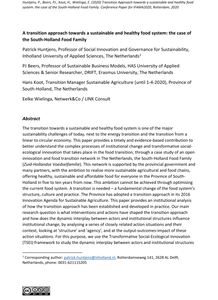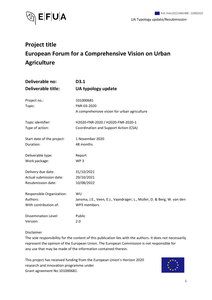Presentation held at the National Conference ADT Baramati, India on the 6th February 2024
DOCUMENT

The study of moral reasoning in relation to sustainable development is an emerging field within environmental education (EE) and education for sustainable development (ESD). The vignette method was used to evaluate the perception of the relationship between environmental and social issues in the Dutch upper elementary school children. This case study is placed within two broad areas of tension, namely between the need to address urgent environmental problems and to promote pluralistic democratic learning; and between the value of environment as an economic asset and deep ecology perspective. Results of this study indicate that the children are able to critically think about the moral dilemmas inherent in sustainable development and distinguish between different values in relation to environment. https://doi.org/10.1016/j.stueduc.2013.12.004 https://www.linkedin.com/in/helenkopnina/
MULTIFILE

The transition towards a sustainable and healthy food system is one of the major sustainability challenges of today, next to the energy transition and the transition from a linear to circular economy. This paper provides a timely and evidence-based contribution to better understand the complex processes of institutional change and transformative social-ecological innovation that takes place in the food transition, through a case study of an open innovation and food transition network in The Netherlands, the South-Holland Food Family (Zuid-Hollandse Voedselfamilie). This network is supported by the provincial government and many partners, with the ambition to realize more sustainable agricultural and food chains, offering healthy, sustainable and affordable food for everyone in the Province of South-Holland in five to ten years from now. This ambition cannot be achieved through optimising the current food system. A transition is needed – a fundamental change of the food system’s structure, culture and practice. The Province has adopted a transition approach in its 2016 Innovation Agenda for Sustainable Agriculture. This paper provides an institutional analysis of how the transition approach has been established and developed in practice. Our main research question is what interventions and actions have shaped the transition approach and how does the dynamic interplay between actors and institutional structures influence institutional change, by analysing a series of closely related action situations and their context, looking at 'structure' and 'agency', and at the output-outcomes-impact of these action situations. For this purpose, we use the Transformative Social-Ecological Innovation (TSEI)-framework to study the dynamic interplay between actors and institutional structures influencing institutional change. The example of TSEI-framework application in this paper shows when and how local agents change the institutional context itself, which provides relevant insights on institutional work and the mutually constitutive nature of structure and agency. Above institutional analysis also shows the pivotal role of a number of actors, such as network facilitators and provincial minister, and their capability and skills to combine formal and informal institutional environments and logics and mobilize resources, thereby legitimizing and supporting the change effort. The results are indicative of the importance of institutional structures as both facilitating (i.e., the province’s policies) and limiting (e.g. land ownership) transition dynamics.
DOCUMENT

The shift towards a more sustainable circular economy will require innovations. While SMEs can contribute to this development, financing innovations within SMEs is difficult. Various authors have not ed moreover that the concept of the circular economy has further increased the complexity of investment decisions concerning sustainable innovations, due to the multiple value creation and new business models involved . On the other hand
DOCUMENT

This book contains the abstracts to the sessions presented at the AESOP Sustainable Food Planning conference in 2022. The conference was made up of four tracks: social inclusion; urban agriculture; urban planning, design and development; food governance.
DOCUMENT

The EIP-AGRI Focus Group on Bee health and sustainable beekeeping was established in spring 2019 to identify, structure and develop main replies to the main question: How can we ensure the sustainability of beekeeping in the face of challenges linked to pests and diseases, intensification of agriculture and climate change?
DOCUMENT

Although urban agriculture as a way to come to sustainable urban food systems can be questioned and we have to be aware not falling into a ‘local trap’ regarding its benefits (Born & Purcell, 2006), initiatives for urban agriculture emerge all over the world. Some of these primarily focus on achieving social and educational goals while others try to become an (high tech) alternative to existing food supply chains. Whichever the goals of urban agriculture, in practice many of these initiatives have difficulties in their (logistics) operations. Research on urban agriculture and local‐for‐local food supply chains mainly focuses on environmental and economic benefits, alternative production techniques, short food supply chains (logistics infrastructure) or socio‐economic benefits of urban agriculture. So far, the alignment of urban agriculture goals with the chosen logistics concept – which includes more aspects than only infrastructure – has not gained much attention. This paper tries to fill this gap through an exploration of urban agriculture projects – both low and high tech – from around the world by using the integrated logistics concept (Van Goor et al., 2003). The main question to be answered in this paper is: to what extend can the integrated logistics concept contribute to understanding logistics drivers and barriers of urban agriculture projects? To answer this question, different urban agriculture projects were studied through information on their websites and an internet based questionnaire with key players in these projects. Our exploration shows that the ILC is a useful tool for determining logistics drivers and barriers and that there is much potential in using this concept when planning for successful urban agriculture projects.
MULTIFILE

Urban Agriculture (UA) is rapidly evolving and changing and often entails more than the production of food. EFUA’s Working Package 3 therefore aims to identify the types and benefits of UA in the European context. This report is an update of the typology as described in the COST Action UAE. As existing typologies are often based on subjective observation rather than on empirical data and are also one-dimensional, this study is based on a systematic literature review about characteristics and existing typologies of UA, interviews with sixteen experts in the field representing eleven European countries and a questionnaire about specific UA initiatives amongst 112 respondents.
DOCUMENT

VHL University of Applied Sciences (VHL) is a sustainable University of AppliedSciences that trains students to be ambitious, innovative professionals andcarries out applied research to make a significant contribution to asustainable world. Together with partners from the field, they contribute to innovative and sustainable developments through research and knowledge valorisation. Their focus is on circular agriculture, water, healthy food & nutrition, soil and biodiversity – themes that are developed within research lines in the variousapplied research groups. These themes address the challenges that are part ofthe international sustainability agenda for 2030: the sustainable developmentgoals (SDGs). This booklet contains fascinating and representative examplesof projects – completed or ongoing, from home and abroad – that are linked tothe SDGs. The project results contribute not only to the SDGs but to their teaching as well.
DOCUMENT
